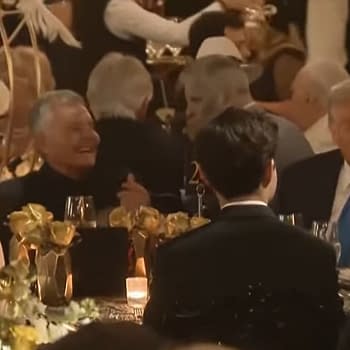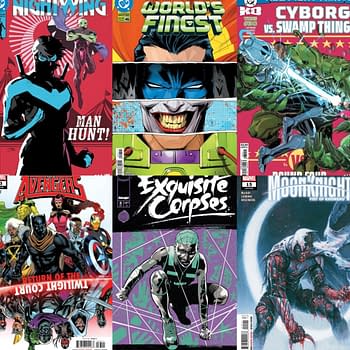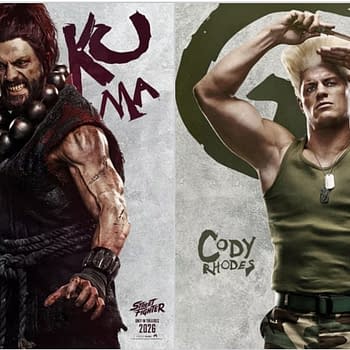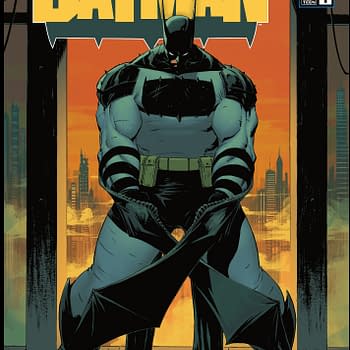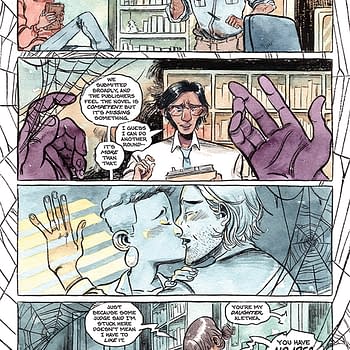Posted in: Comics | Tagged: chris sprouse, Comics, dc, pete hogan, tom strong
Pulp Champion Tom Strong Faces New Perils
Sitting down to read a new Tom Strong comic is incredibly nostalgic for me, and probably for many readers. Alan Moore's ABC comics line-up felt like a radical thing when it first emerged. Promethea, Top 10, and Tom Strong were visually exciting, brightly colored, crisp-lined and had a kind of flexibility and humor to them that seemed to be all about a celebration of comics tradition and stood in pretty stark contrast to the assumed "grim and gritty" hero tradition Moore is accused of heralding through Watchmen. In fact, in interviews he's confirmed that the ABC comics were intentionally designed to reintroduce a more positive note to hero stories and bring back some of the glamor of the pulp traditions that Moore found inspiring.
The success of the comics in doing so was also down to the excellent artists working on the line, from J. H. Williams III and guest artists on Promethea to Gene Ha and Zander Cannon on Top 10, and the inestimable Chris Sprouse on Tom Strong. They each created a texture for their comics that challenged the senses, that could be both stern and carnivalesque, but when it comes to hero stories, Sprouse really reinvented the power of pulp lines. His characters in Tom Strong seem carved out of stone, embedded in heroic poses, but given to Olympian muscularity of movement and even an Olympian sense of humor straight out of the strange family-drama tales of Greek myths.

It would be difficult to pick out a Tom Strong comic that wasn't in some ways about family. Robots of Doom was based on the twisted impact of family relationships in terms of its plot, and gets a standing ovation for pointing out how one messed up family dynamic could potentially destroy the world. But The Planet of Peril is taking us back into the core of the Strong family ethos, a kind of bullet-proof emphasis on the ways in which Tom's heroic family is a team. Those relationships have always rendered Tom, Dhalua, Tesla, and later Val (not to mention Solomon and Pneuman) very human as they engage in utterly fantastic situations, and one of the most appealing aspects of this unit is the fact that it is reactionary. Tom has essentially built a family for himself because he never had one growing up, locked by his parents in a gravity chamber to promote super-human strength and development. He's an experiment gone right, physically, but an experiment in progress emotionally.
For that reason family will always be the one thing that Tom really has the potential to lose, and so he will fight hardest for it, and suffer most for it. The Planet of Peril seems to be about bringing two elements together from the Tom Strong comic tradition: Tom's desire to protect his family, and his curiosity about alternate worlds. Without giving too much away for those picking up the comic in the next couple of days, I'll say that Tom's daughter Tesla is in danger in issue #1 and this drives Tom to seek out Terra Obscura and the help of his alternate self Tom Strange once again. That means that The Planet of Peril is going to be a fairly emotional and psychological storyline when it comes to examining Tom's character, with the potential to examine other characters closely too, as they are placed in stressful situations where they hold other lives in their hands. But it also wouldn't be a Tom Strong comic without a certain amount of irreverent layering of references that play to irony or outright commentary on the comics medium itself. Watch out for those: they are an excellent and sparky element in the story that add plenty of flavor to the plot.
Sprouse's pencils are inked by Tom Strong veteran Karl Story with sensitively nuanced colors from Jordie Bellaire, and one of the most iconic features of Tom Strong also returns here, lettering by the great Todd Klein. Klein's letters have been almost as definitive in Tom Strong as Sprouse's lines to give the series that Olympian feel and that science-hero accent. It's a super-powered art team, really, which gives The Planet of Peril every advantage to stand alongside earlier Tom Strong comics. Opening the cover of issue #1 is a bracing breath of fresh air for those hoping to encounter Tom Strong again and find him undiminished and his adventures no less intriguing. It's as if we've only stepped away from him a moment or two between Robots of Doom and this new arc and Tom Strong's world has been churning ahead just as vibrantly as ever in the meantime. To do that with a character and a world essentially grounded in pulp tradition is an achievement, to disengage from any musty sense of overly developed homage, but that was always a goal in the series from its inception, and we might note that other creators have since taken up pulp influences with the same lofty intentions.
Reading The Planet of Peril reminds us what pulp comics are about in the 21st century, about the ways that they can still reach us through their own brand of simplicity, not just as a form of nostalgic replication, but through stripping down to their core elements and settling on what resonates. And Tom Strong certainly resonates in both artwork and story. There's no reason why comics can't be beautiful and meaningful, too. In fact, that is the particular forte of comics and why they have survived in an age of increasing technological innovation, in print or digital, by panel or page. Pulp elements isolate those features and remind us of the history of comics, but they also tell us about the future of comics. Some day, hopefully, creators will be handling the popular movements of the first decades of the 21st century in the same way, gauging what still stands up, what to preserve and carry forward, and how to make those materials their own.
Hannah Means-Shannon writes and blogs about comics for TRIP CITY and Sequart.org and is currently working on books about Neil Gaiman and Alan Moore for Sequart. She is @hannahmenzies on Twitter and hannahmenziesblog on WordPress. Find her bio here.








